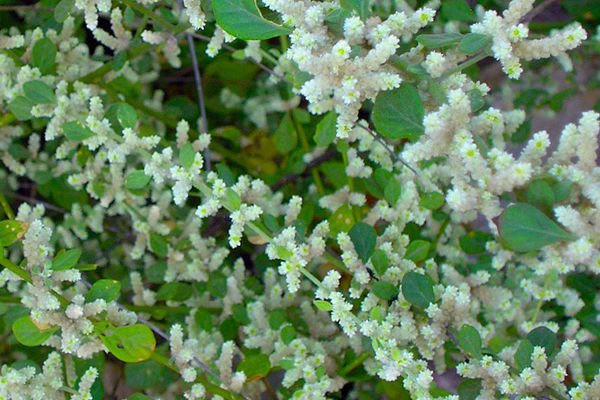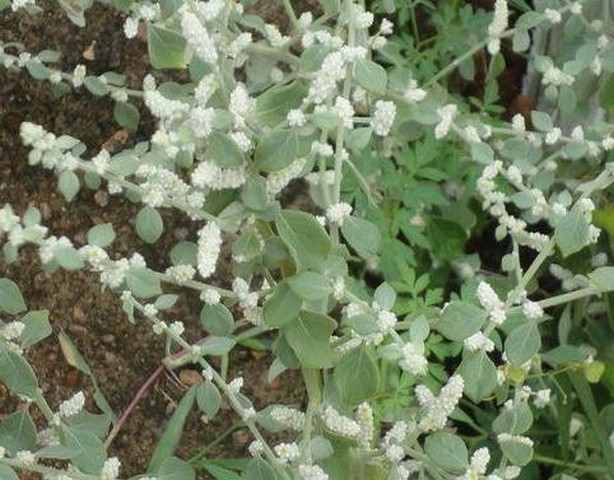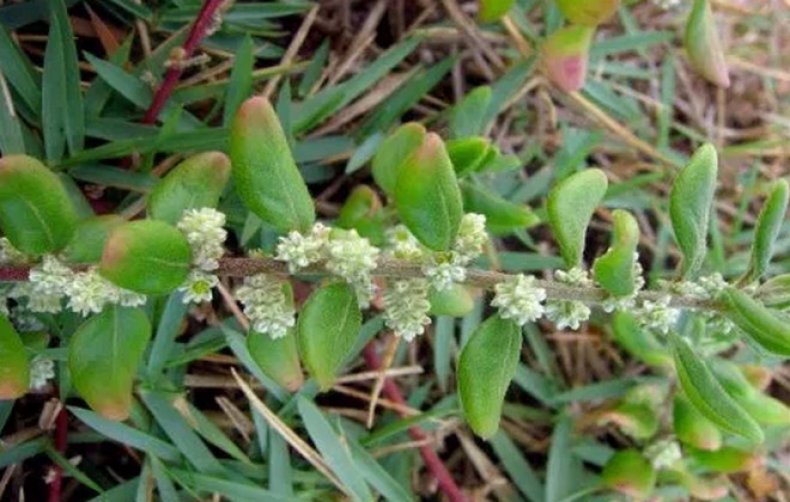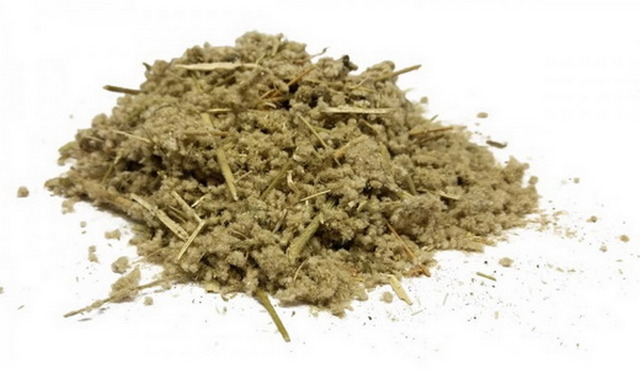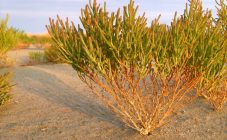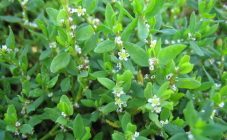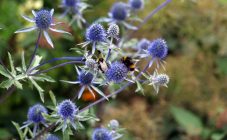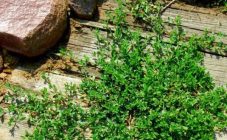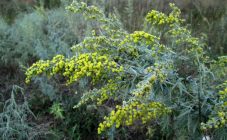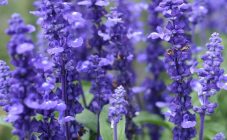Content:
Half-fallen - a herb that belongs to the Amaranth family, grows in India, Australia, Africa, Indonesia, on the Arabian Peninsula. It has an official name - woolly erva. Since 1977 it has been cultivated in Georgia, but in Russia and in the territory of the former USSR, this herb does not grow wild.
Description of culture
The half-dead grass belongs to the group of biennial plants. Her description:
- The bush rises upwards by 1.3-1.4 cm. It rests on a rod-type root, which has several branches. The length reaches 0.18 m, and the diameter is 6-7 mm. The root color is gray or white.
- Has strongly branching branches, creeping or erect green stems. Their diameter reaches 10 mm.
- The leaves of this herb are elliptical or round, with short petioles. They are 20 mm long and about 15 mm wide.
- The flowers of the plant are inconspicuous, with a simple whitish perianth. They consist of 5 parts and are assembled into long spikelets.
- The fruit looks like a round box with a slightly elongated nose.
The herb has half-died in medicine, the stems and leaves contain various alkaloids, phenolic acids and other substances useful for humans. It is used to treat gynecological and other diseases.
Erva woolly can be wild and domesticated. For the purpose of health improvement, people use the second herbal type of plant, since the burnt tree growing in nature must first be rid of some components dangerous to humans.
The grass grows on rocky and sandy soil. Erva tolerates lack of moisture and slight shading well. The grass is not afraid of the heat.
She cannot stand a cold snap. For example, spring night frosts. But the wild-growing herva herb resists fungal and bacterial infections well. Its cultural counterpart most often dies from viral infection or insect attacks.
The grass is propagated by seeds. It is better to purchase seed from reputable producers, they pre-process the product, which makes it easier to grow grass.
First, seedlings are obtained from the seeds, and then the plant is transferred to the garden. In Russian conditions, in order to obtain a full-fledged medicinal herb in a greenhouse, it is necessary to create conditions close to the subtropics.
Properties and application
Erva, like the herb pollok, is used for lesions of the renal structures and other diseases.
Instructions for using the herb half-fell says that it is prescribed to patients with the following ailments:
- edema of a different nature;
- arterial hypertension;
- urolithiasis disease;
- ovarian tumors;
- inflammation of the bladder;
- violation of the salt balance;
- gout;
- arthritis;
- spondylosis;
- rheumatic pains;
- pancreatic lesions;
- prostatitis;
- inflammation of the appendages;
- problems with the menstrual cycle;
- diabetes;
- violation of salt metabolism;
- acute lesions of the respiratory system;
- intestinal polyposis;
- tracheitis and bronchitis.
- pyelonephritis.
Half-pala grass can be used to cleanse the body of toxins and toxins, but it is better to do this under the supervision of your doctor.The raw material is sold in the form of dried compressed grass packed in cardboard boxes. But before you start using the drug, you need to familiarize yourself with the contraindications. In case of individual intolerance to its constituent components, the agent should not be used.
There is practically no data on drug overdose and its interaction with various medications, on the adverse effects of the herb on pregnant women and children.
For the treatment of diseases, according to indications, it is recommended to use a herva decoction. It cleanses the urinary tract, can eliminate ulcers and gastritis. The drink allows you to remove small stones from the kidneys, cleanse the organ of sand.
In some cases, Erva is used to remove radionuclides from the human body.
Diseases and pests
Like all plants, the grass is prone to attack by garden parasites. The most dangerous of them are the following insects:
- spider mites;
- green aphids;
- weevils;
- slobbering penny;
- ants;
- caterpillars of various butterflies;
- bear;
- slugs.
They destroy leaves, shoots, flowers. But you can get rid of them:
- To combat the spider mite, modern drugs are used that kill this pest.
- Green aphids are eliminated with a soapy solution sprayed onto the planting. To protect against it, you can plant thyme next to the erva.
- Weevils are simply shaken off the plant and then collected and burned. If there are a lot of them, then the bushes need to be treated with pepper infusion or a solution of potassium permanganate.
- The slobbering penny is thrown from the stems with a stream of water from a hose.
- Ants and caterpillars are easiest to poison with special preparations.
- To scare away bears, it is recommended to loosen the ground under the plants.
- Slugs are driven off by scattering wood ash near the roots of the grass, treating the stems with an aqueous solution of this substance.
Erva can die from spring frosts if its seedlings are not protected with warm material.
Although the weed is resistant to fungal diseases, it is most often affected by powdery mildew. To combat the disease, it is necessary to constantly cleanse the garden of plant residues.
Gray mold affects both trunks and leaves on bushes. To eliminate the problem, you need to spray the plantings with Bordeaux liquid.
If a bloom similar to fine soot has formed on the plant, all affected parts must be quickly removed, and then the herva must be treated with preparations containing copper.
If signs of rust appear on the grass, to combat it, you need to eliminate the affected areas, and then spray the plantings with fungicides.
If the soil is very wet or contains a lot of acid, a black leg may appear. To eliminate the danger, it is necessary to deacidify the soil, treat the lower parts of the grass with wood ash.
When symptoms of any viral disease appear, systematic weeding of the soil is recommended. There is no cure for such lesions, so it is necessary to eliminate the carriers of infection - various insects.
Collection and preparation of grass
To have a supply of grass (it can be stored in dried form for about 3 years), you need to wait until autumn. It is during this period that the pala stops growing. And at the end of August, flowers appear on it. Woolly Erva is taken out of the garden along with the roots. It is not necessary to pull the plant, it is better to dig it up. Then you need to rinse the crop from clods of earth. The stems are cut into pieces that will be conveniently stored.
Raw materials are dried in a dry, well-ventilated area. Some farmers try to carry out this operation in an oven or stove. This is not recommended, since useful components begin to evaporate from the excess heat from the stem and leaves. You need to store the grass in a dry place where the sun's rays do not penetrate.
A gardener who decides to grow herva must have a greenhouse. If you just plant seedlings in the garden, due to insufficient temperature and humidity, the weed will not pick up the necessary medicinal elements. Therefore, you need to follow all the advice of experts on growing subtropical plants in the climatic conditions of Russia.
